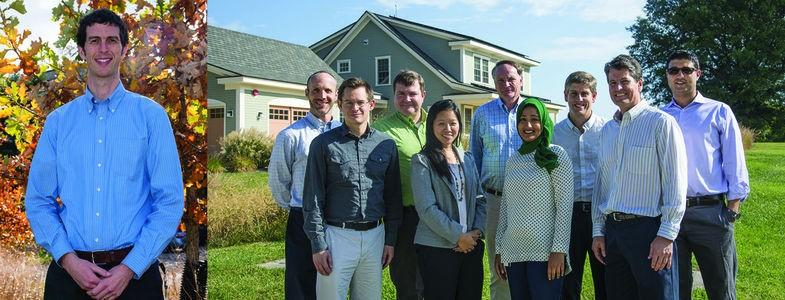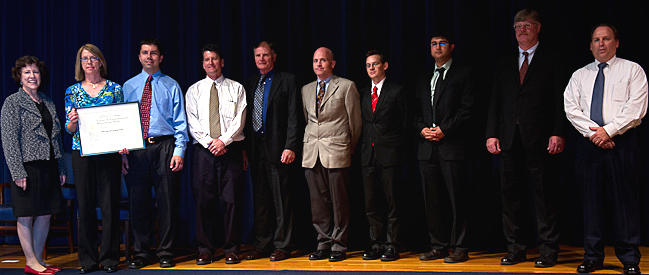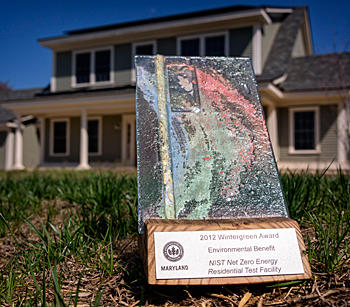NZERTF Recognition
Net-Zero Team of Researchers Honored with NIST Rabinow Award
A team of researchers was honored with the Jacob Rabinow Applied Research Award for 2016 for the development of the Net-Zero Energy Residential Test Facility (NZERTF). The team consisted of Brian Dougherty, A. Hunter Fanney, William Healy, Lisa Ng, Joshua Kneifel, Farhad Omar, Dustin Poppendieck, Harrison Skye, Tania Ullah, and W. Vance Payne. The Rabinow Award, first presented in 1975, is granted for outstanding achievements in the practical application of the results of scientific engineering research. This group was recognized for developing a unique testbed to evaluate equipment and design approaches to achieve energy efficient residential buildings with improved indoor environmental quality. This residential test facility provided all the amenities expected in a typical American home, but with extensive sensing and automation to carefully monitor energy and indoor environmental performance. The knowledge gained from the extensive data collection and analyses is already leading to changes in the way that builders design and construct homes; equipment manufacturers design systems for homes; and industry groups quantify building performance.

Net-Zero Team of Technicians Honored with NIST Crittenden Award
A team of engineering technicians who developed and installed the sensing systems that monitor the performance of the NIST Net-Zero Energy Residential Test Facility (NZERTF) were awarded the Eugene Casson Crittenden Award in 2015. The team is comprised of Art Ellison, Glen Glaeser, Dan Greb, Luis Luyo, and John Wamsley. This award, established in 1967, recognizes superior achievement by permanent employees who perform supporting services that have a significant impact on technical programs beyond their own offices. The group is recognized for their exemplary efforts that enabled the demonstration of net-zero for the NZERTF while maintaining the facility as a key destination for public tours and outreach. Their outstanding attention to detail, cooperative manner, and timely actions enabled the operation of the NZERTF with a virtual four-member family, while capturing detailed performance metrics for each of the systems in the facility as well as the facility as a whole. Their extraordinary efforts enabled the NZERTF to operate flawlessly during demonstration of net-zero, with a data capture rate that exceeded 99.5 %.
Net-Zero Team Honored with Department of Commerce Energy and Environmental Stewardship Award
Susan Cantilli, Mark Davis, Brian Dougherty, A. Hunter Fanney, Daniel Gilmore, William Healy, Robert Hellmuth, Joshua Kneifel, Farhad Omar, William V. Payne were honored April 24, 2013, with the Department of Commerce's "Lean, Clean, and Green Award." The team was recognized for exemplary contributions that resulted in the Net-Zero Energy Residential Test Facility.
After its proposal resulted in American Recovery and Reinvestment Act Funding for this project, the team immediately sought the advice of leading energy efficiency practitioners at NIST and elsewhere. It developed a list of current technologies and envisioned future energy-efficient technologies for which a test bed would be needed to develop methods of test and performance metrics. The group worked with an architectural team to fully integrate the test bed capabilities into a residential structure design, and conducted computer simulations to ensure design intent would be achieved. The team's efforts continued during the preparation of the specification/bid package and during construction, when team members worked closely with the every trade (such as plumbing and electrical) to convey the need for extreme attention to detail. The team's continuous oversight ensured that the design intent was fully met.
The intense design effort began in July 2010, and the facility was completed in Sept. 2012.

NIST team receiving Department of Commerce's 2013 Lean, Clean, and Green Award. The recipients of this Energy and Environmental Stewardship Award are (left to right) are: Senior Advisor to the Deputy Secretary Ellen Herbst, Susan Cantilli, Mark Davis, Brian Dougherty, A. Hunter Fanney, Daniel Gilmore, Joshua Kneifel, Farhad Omar, Robert Hellmuth, and Michael Szwed. (Not pictured are William Healy and Vance Payne).

2012 Wintergreen Award for Excellence

More than 250 members of Maryland's sustainable community attended the Wintergreen Awards to celebrate the winners and to recognize their contribution to market transformation and keeping Maryland a leader in green building. To qualify for a Wintergreen Award, the project or organization must be located in the state of Maryland and be sustainable.
Nominations are judged on a series of sustainable measures including, but not limited to, innovation in sustainable design, environmental impact, social benefit, community involvement, and achievement within green building rating systems.
Net-Zero Energy Residential Test Facility Receives U.S. Green Building Council's LEED Platinum Certification
In Sept. 2012, the facility earned the U.S. Green Building Council's highest rating for homes. According to the council, "LEED (Leadership in Energy and Environmental Design) is a voluntary, consensus-based, market-driven program that provides third-party verification of green buildings. From individual buildings and homes, to entire neighborhoods and communities, LEED is transforming the way built environments are designed, constructed, and operated. Comprehensive and flexible, LEED addresses the entire lifecycle of a building.
"Participation in the voluntary LEED process demonstrates leadership, innovation, environmental stewardship and social responsibility. LEED provides building owners and operators the tools they need to immediately impact their building's performance and bottom line, while providing healthy indoor spaces for a building's occupants."
NZERTF Certified to Meet EPA's Energy Star Guidelines
To earn the ENERGY STAR, a home must meet strict guidelines for energy efficiency set by the U.S. Environmental Protection Agency (EPA). Homes achieve this level of performance through a complete package of building science measures including:
- a complete thermal enclosure system
- a complete heating and cooling system
- a complete water management system
- energy-efficient lighting and appliances
The result is a home with:
- lower utility bills—ENERGY STAR certified homes save approximately 20% on annual utility bills
- enhanced performance such as consistent temperatures between and across rooms, better indoor air quality, and more durability through comprehensive water protection, windows that block damaging sunlight, and better grade equipment; and
- a protected environment—by using less energy to operate, ENERGY STAR certified homes help to prevent air pollution

